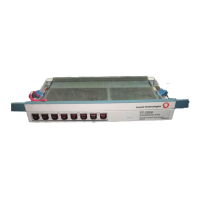Administration and Provisioning
8-44 Issue 8.0 July 2002
— A
2-way
cross-connection is entered by first specifying a 1-way
source and destination. The source may be a low-speed interface
slot, a low-speed interface slot in a slot pair (for example, slot 2A
and 2B) provisioned for the OC-3 1+1 protected mode, or an STS-3
tributary. If the source is a low-speed interface slot, the destination
must be an STS-3 tributary. If the source is an STS-3 tributary, the
destination must be a low-speed interface slot, a low-speed
interface slot in a slot pair provisioned for the OC-3 1+1 protected
mode, or the same-numbered STS-3 tributary on the OC-48
high-speed line in the opposite direction. If the source is an STS-3
tributary, the source node TID must be specified. If the destination is
an STS-3 tributary, the destination node TID must be specified.
After the user specifies the first 1-way source and destination, the
FT-2000 OC-48 Add/Drop-Rings Terminal automatically enters the
corresponding 1-way source and destination in the opposite
direction. This creates a 2-way cross-connection.
An input requesting a 2-way cross-connection will be denied if the
specified source is already cross-connected to a different
destination, or if the specified destination is already cross-connected
to a different source. This input will also be denied if the specified
destination is already involved in a 1-way-DRI cross-connection.
The source node TID and the destination node TID of an STS-3 tributary
are required to support squelching during a 2-fiber ring protection switch. If
an STS-3 tributary is specified as the source, the source node TID must be
specified. The source node is the node in the ring where the low-speed
signals on that STS-3 tributary originate. If an STS-3 tributary is specified
as the destination, the destination node TID must be specified. The
destination node is the node in the same ring where the low-speed signals
on that STS-3 tributary terminate. If an STS-3 tributary is bridged at one or
more nodes in a ring, the last node where the low-speed signals are
terminated must be specified as the destination node. For more information
about 2-fiber ring protection switching and squelching, refer to Volume I,
Section 9, "Maintenance Description."
The CONFIGURATION-Enter-Crossconnection-STS3 input can also
be used to change the values of the source and destination node
parameters(nodeIDsorTIDs)associatedwithanexisting
cross-connection. This is accomplished by reentering the same
cross-connection with the new node IDs or TIDs for the source and/or
destination nodes.

